For retailers and etailers, customer loyalty is a crucial aspect of sustainable success. Loyal customers are much more than a steady source of sales; they have been shown to spend an average of 33% more per order than new customers. What’s more, their business is cheaper and easier to acquire.
So, how do you win over more loyal customers? While a phenomenal product catalog and friendly service will get you much of the way there, today’s shoppers have plenty of options – and they expect you to go the extra mile in the battle for their hearts and wallets.
In this article, we’ll discuss how to understand and track customer loyalty. Then, we’ll introduce effective strategies to turn what might otherwise have been one-off customers into lifelong fans.
What is customer loyalty?
Put simply, customer loyalty is the degree of commitment and attachment that a customer has towards a particular brand, product, or service.
It might start with a single purchase, but over time, it evolves into a strong and lasting relationship between the customer and the business.
In growing customer loyalty, your goal is ultimately to increase customer retention – i.e. to keep existing customers engaged and satisfied so that they provide repeat business.
Whereas loyalty is the feeling you want to inspire in your customers, retention is the behavior you want to result from that feeling: namely, continuing to interact with your brand and shop at your store.
A business that retains loyal customers reaps plenty of benefits in both the long- and short-term.
Increased revenue
First and foremost, loyal customers make repeat purchases from your business. They’re more likely to default to choosing your brand over competitors
Not only do these sales provide you with a steady stream of revenue; they’re also high-value transactions compared to purchases by new customers. That’s because nurturing existing relationships takes substantially less time and fewer resources than building on new ones.
In fact, depending on your industry and growth stage, studies indicate that acquiring new customers may be anywhere from 5 to 25 times more expensive than retaining old ones.
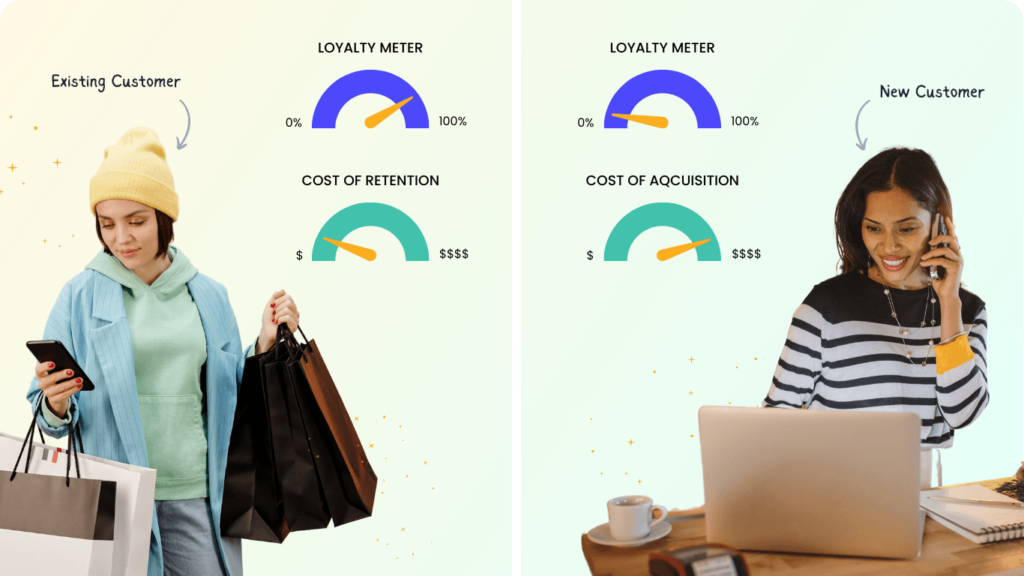
Brand advocacy and engagement
Loyal customers don’t just buy more from you; they encourage others to do so, too.
Imagine that you have a frequent customer named Anna. Her age, lifestyle, and interests make her a perfect example of your ideal customer profile. So are many of her friends, and the people who follow her on social media – only, they don’t know about your brand yet.
By drumming up Anna’s enthusiasm for your business, you can turn her from a regular shopper to an active ambassador of your brand.
She’ll leave positive reviews of your products, talk about you over coffee with her friends or coworkers, and sing your praises on social media. Every person she “converts” is yet another potential brand advocate.
People trust recommendations from those they know, or from those who seem similar to them. Multiply Anna by a dozen, then 100, and you’re well on your way to growing a credible reputation.
What is Customer Lifetime Value (CLV)?
Customer Lifetime Value (CLV) is the total amount of revenue a customer generates throughout their relationship with your business. That includes both past and projected future purchases.
CLV is a way of translating the abstract concept of “loyalty” into actual revenue. That’s why it’s a key metric to track. Focusing on increasing your customers’ average CLV will help you drive sustainable growth: as you learn what resonates well with your existing customers, you’ll become more adept both at strengthening their loyalty and turning new shoppers into loyal followers.
CLV is highly useful as you refine your ideal customer profile(s). Use it to identify your best customers and figure out what they have in common. That might include demographics such as age, gender, and location; or shopping behavior and purchase patterns.
The better a sense you have of your ideal customers, the more effectively you can find and target new ones who share their key characteristics. These potential customers have a relatively high chance of purchasing and becoming loyal.
All customers can be assigned an individual lifetime value score. To determine and track an average CLV score amongst all your customers, use this formula:
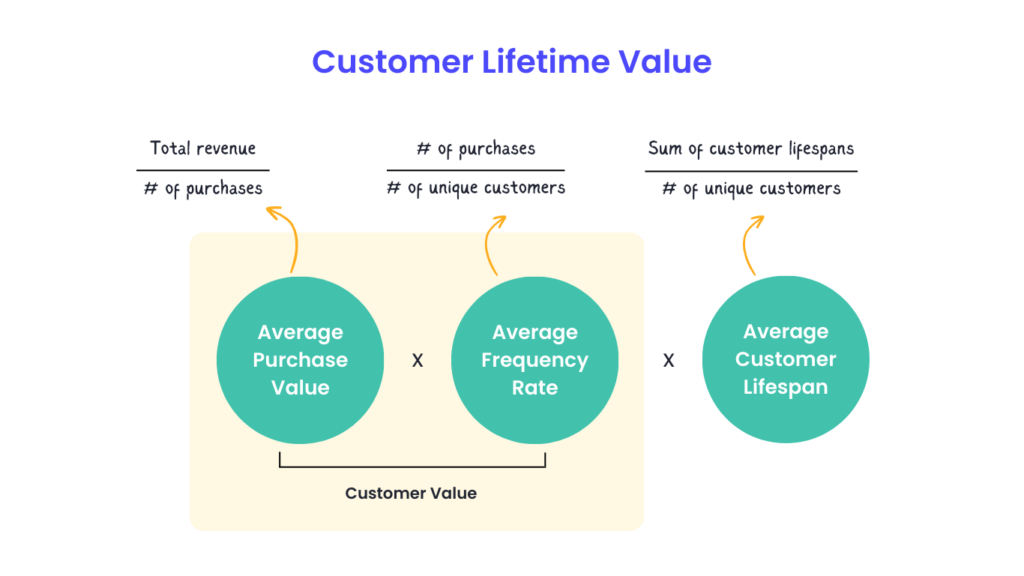
Challenges in growing customer loyalty
Growing customer loyalty is a worthy goal for any business, but it takes dedication. Here are some of the most common challenges companies face in improving their customer loyalty:
- Too little differentiation in a competitive market
- Insufficient understanding of what customers want
- Too few personalized shopping experiences
- Prioritizing short-term gains over long-term relationships
In other words, no matter how great your products may be, you can’t just sit back and watch customer loyalty happen. You’ll need to nurture it with an active, strategic approach.
Strategies to increase customer loyalty
Loyal customers don’t just love one thing about your business – they return for the overall excellent experience of shopping with you.
Here are four areas you’ll need to give close thought to as you design your loyalty-building strategy.
- Personalized experiences
Today’s customers expect personalization throughout their shopping journey. That means relevant recommendations and promotions, and a sense that they are known and valued. Check out our article on personalization for ideas on how to get started. - Consistent engagement
This doesn’t mean spamming customers with generic emails. It’s about having an active presence in the online and physical spaces your customers enjoy, and facilitating two-way interactions. Inviting customers to share user-generated content such as photos and videos, participate in contests, and leave reviews are all steps in the right direction. - Quality products
This goes without saying, but all the loyalty programs in the world can’t help you if your product catalog isn’t meeting customer needs. If customers don’t seem interested in engaging with you beyond an initial purchase, it’s worth reviewing your products’ quality and market fit. - Empathetic service
A whopping 90% of customers say a positive experience with a support agent would make them more likely to repurchase from a business. Providing flexible, friendly, and human service is just as important as ever.
What is a customer loyalty program?
An effective customer loyalty program can become your driving force in growing your fan base.
At a basic level, customer loyalty programs reward customers for shopping or engaging with your business. They foster trust by showing customers that you value them and are focused on their needs.
Loyalty programs take a range of structures, but these three are among the most common:
- Points-based programs
Customers earn points for purchases, which can be redeemed for discounts, free products, or other rewards. - Tiered programs
Customers progress through different levels or tiers based on their loyalty, unlocking increasing benefits and exclusive perks at higher tiers. - Cashback programs
In this popular format, customers receive a percentage of their purchase value back as cash or store credit, encouraging repeat buying and loyalty.

Source: Starbucks Rewards
Key elements of a successful customer loyalty program
No matter how you choose to structure your program, there are a few best practices to keep in mind.
Firstly, don’t make things too complicated. Customers should be able to clearly understand how the program works without too much reading. Create simple terms and conditions for your rewards, including how they are earned and how they can be redeemed.
Secondly, map out ample channels and key moments to communicate about your program, both to new customers and those who are already involved. Remind them about the benefits of the program, update them on their points balance, and suggest (personalized) ways they can make use of their rewards.
Most customers will already be members of several loyalty programs, so yours may not always be top of mind. By designing a format that’s easy to use, and keeping it fresh in shoppers’ minds, you’ll maximize the chances of them taking advantage.
Examples of popular customer loyalty programs
These well-known and beloved loyalty programs show how the strategy can work in a range of industries, using a variety of structures.
IKEA Family
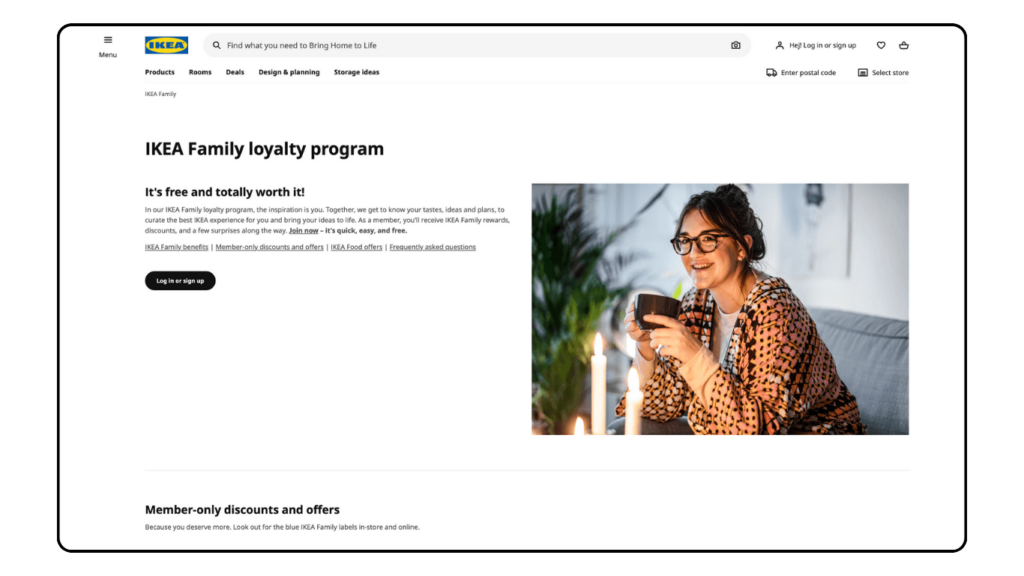
IKEA Family is a popular brand loyalty program that offers various perks and discounts to its members. To join, customers need to create an account on IKEA’s website and verify their phone number.
IKEA doesn’t often make promotions accessible for non-members, so the incentive to join is clear.
The program has over 150 million members and continues to expand. IKEA Family’s mobile app is an important part of the brand’s strategy, keeping customers engaged with text messages and push notifications about new products.
Sephora Beauty Insider
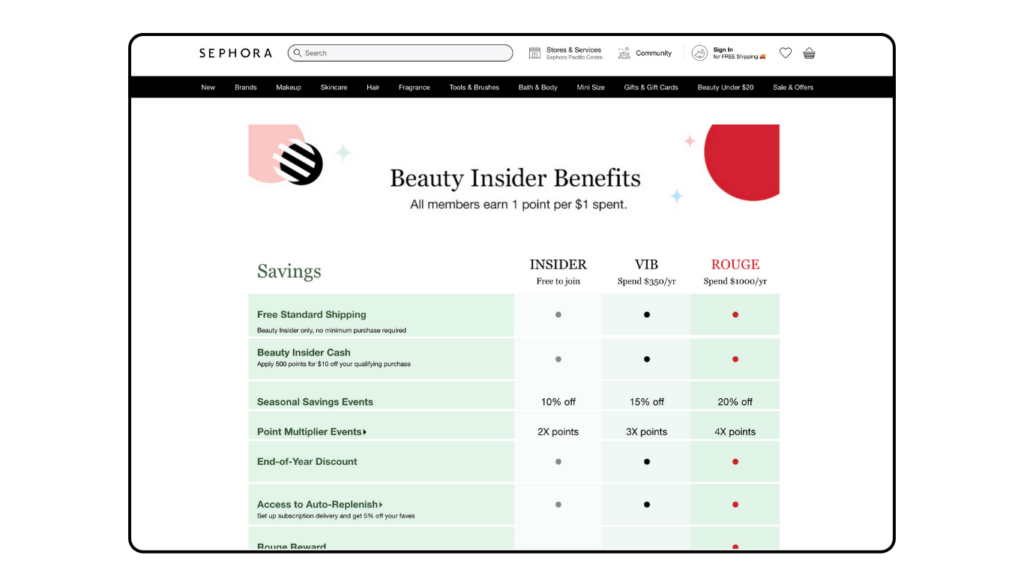
Sephora’s Beauty Insider program rewards customers for purchases, offering points per dollar spent. Members progress through three tiers: Beauty Insider, VIB (Very Important Beauty Insider), and Rouge, with each tier unlocking progressively more enticing perks.
Customers can redeem points for sample-size products or experiences. The program also provides birthday gifts, early access to products, and exclusive events.
Sephora’s tiered approach and diverse rewards cater to various customer preferences, fostering engagement and loyalty within the beauty community.
The North Face Loyalty Program
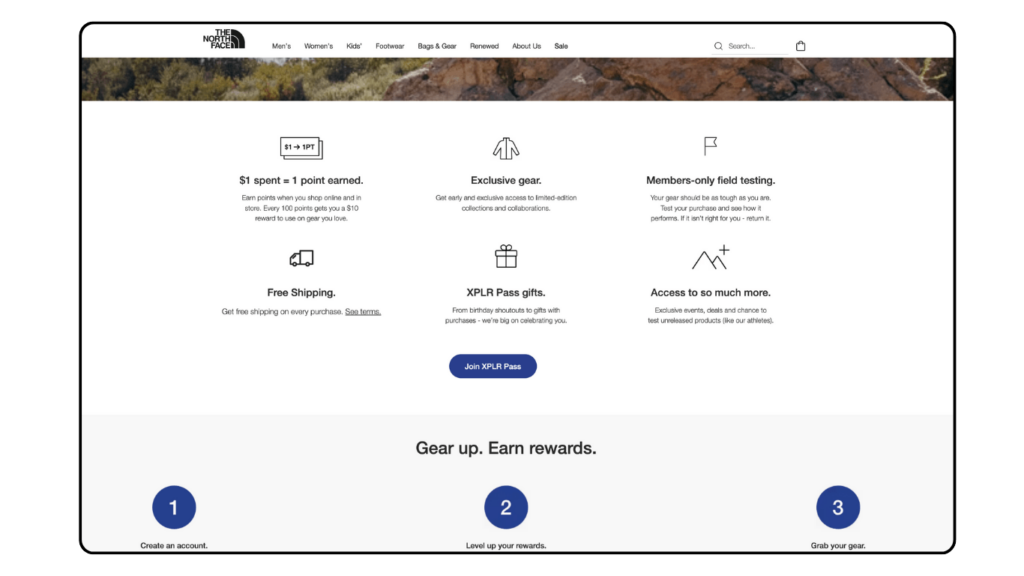
The North Face Loyalty Program is a rewards program that allows customers to earn points for purchases made at North Face retail locations and online.
The program clearly lays out its benefits, which include early access to sales, exclusive discounts, and purchase rewards. Customers can redeem their points for rewards such as $25 certificates or North Face gear.
The program also offers free shipping on orders over a certain amount, as well as special promotions and contests.
To join the North Face Loyalty Program, customers must create an account on the North Face website or at a North Face retail location.
Tracking customer loyalty with analytics
Analytics allow you to measure customer loyalty by providing valuable insights into customer behavior and preferences.
We’ve already covered Customer Lifetime Value (CLV). Another crucial metric is customer retention rate., which gauges the percentage of retained customers over a specific period.
To calculate it, follow these steps:
- Identify the number of customers at the start and end of a specific period.
- Subtract the number of new customers acquired during that period.
- Divide the result by the number of customers at the start of the period.
- Multiply the quotient by 100 to get the retention rate as a percentage.
Another valuable source of insight into customer loyalty can come from surveys. Send out a brief, simple questionnaire to customers asking how likely they are to recommend your brand to a friend, on a scale of 1 to 10. Make it a goal to increase the average response value.
Keeping tabs on metrics like these will help you make data-driven decisions, optimize your loyalty program, and enhance your overall customer experience.
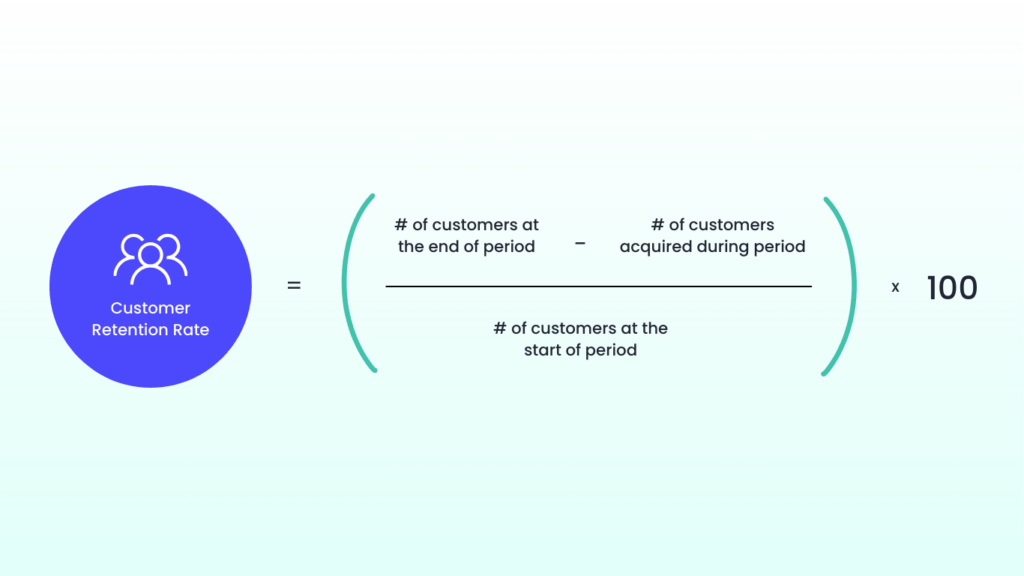
Managing Customer Loyalty
Your customer loyalty strategy should evolve as you gain new levels of insight into your customers.
In addition to tracking metrics, make sure you regularly take stock of customer feedback, both on your website or app and on social media platforms.
Keep an eye on market trends, too. New trends in loyalty programs may change customer expectations.
For example, imagine that you observe a change in shopping preferences in your industry. Rather than shopping on traditional websites, customers are showing a strong preference for making purchases via social media platforms.
Here’s a perfect opportunity to update your loyalty strategy. This could involve integrating loyalty programs directly into social platforms, leveraging influencer collaborations, or focusing on personalized social interactions.
By adapting to these changing market trends, you ensure that your customer loyalty strategy remains relevant and effective in capturing the evolving preferences and behaviors of your target audience.
Loyalty starts with your CRM solution
To design and carry out a strong customer loyalty strategy, you need as much insight as possible into your customers.
Customer Relationship Management (CRM) systems centralize customer data. This allows you to streamline communication. By tracking customers’ preferences and purchase history, you can provide faster service and facilitate the personalized interactions your customers expect.
CRM systems also provide the information and tools you need to target your marketing efforts. Use them to segment your customers based on key characteristics, then roll out customized campaigns that speak to the needs and interests of each group.
Ultimately, the comprehensive insights provided by CRM systems empower businesses to build stronger connections and improve overall customer retention rates.
Breadstack can help you kickstart and manage a customer loyalty strategy that yields results. Get started today with a free demo.

